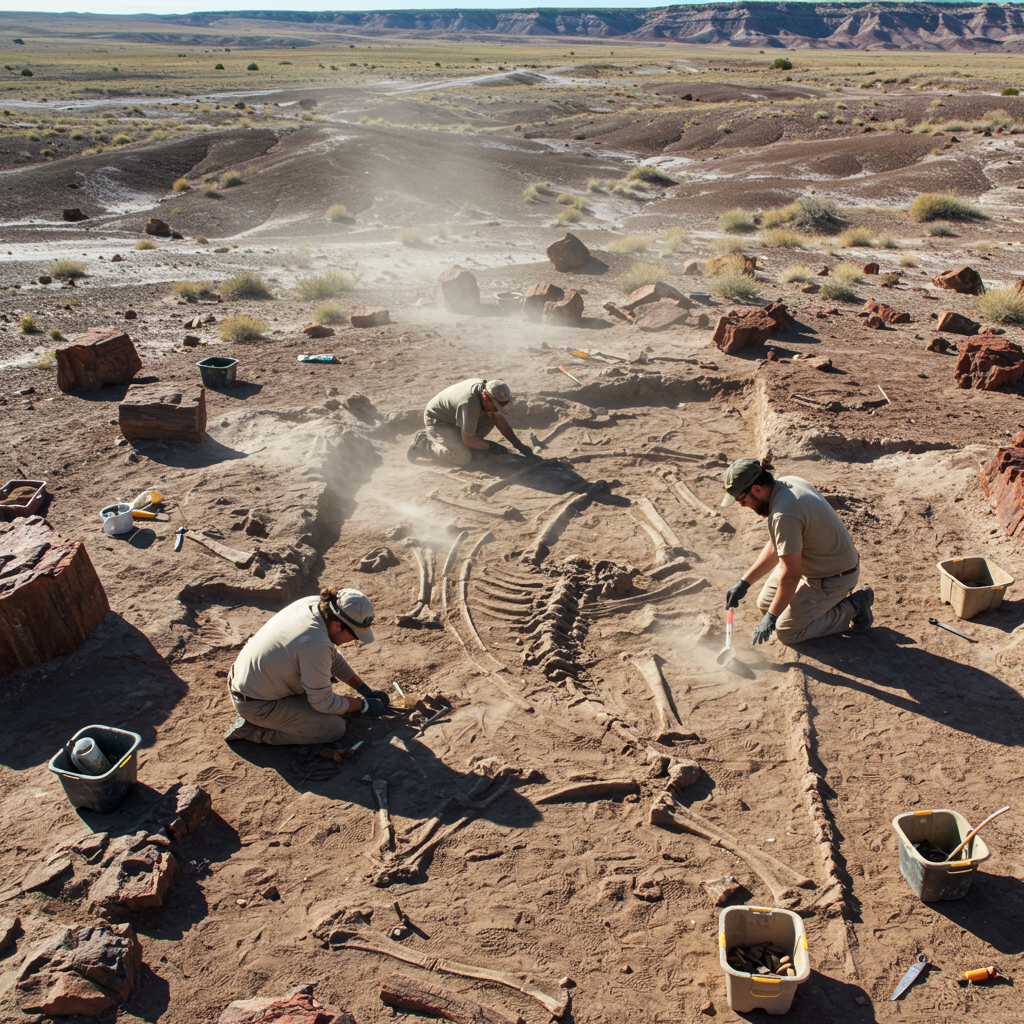Deep within the sun-baked landscapes of Arizona’s Petrified Forest National Park, paleontologists have unearthed a remarkable fossil site. This ancient bonebed, dating back nearly 209 million years, offers an unprecedented look at life just before a major global extinction event. Scientists are particularly excited about one key discovery: the oldest known pterosaur fossil ever found in North America. This find sheds crucial light on how these ancient flying reptiles expanded their reach across the supercontinent Pangaea during the triassic Period, a pivotal time in Earth’s history.
Unearthing a Triassic Treasure Trove
The fossil site, officially known as PFV 393, is located within the Owl Rock Member of the upper Chinle Formation in Petrified Forest National Park. First discovered in 2011 by fossil preparator Bill Amaral during a field trip seeking early reptile fossils, the site presented a unique challenge. The sheer number and small size of the fossils meant they couldn’t be safely excavated in the field. Instead, the team encased sections of the bonebed in protective plaster jackets. These “blind jackets” were then transported to the Smithsonian National Museum of Natural History for meticulous preparation under laboratory conditions. Smithsonian paleontologist Ben Kligman, the lead author of the study published in the Proceedings of the National Academy of Sciences, notes that volunteers spent thousands of hours carefully working to reveal the ancient treasures hidden within these blocks of sediment.
The Delicate Work of Discovery
Recovering fossils from PFV 393 was a painstaking process. The dense concentration of tiny bones required delicate tools and immense patience. The fossils had to be carefully chipped away from the surrounding rock matrix. This lab work allowed researchers to preserve even the most fragile specimens that would have been lost if excavated roughly in the field. The meticulous effort uncovered an astonishing collection – over 1,200 individual fossils representing at least 16 different groups of vertebrate animals. This dense assemblage provides an unparalleled snapshot of a specific ancient ecosystem.
Introducing Eotephradactylus mcintireae: Dawn’s Ash-Winged Flyer
Among the wealth of fossils, three small bones stood out: a lower jawbone with teeth, an isolated tooth, and a finger bone. These sparse remains belong to a newly identified species of pterosaur, named Eotephradactylus mcintireae. At approximately 209 million years old, this makes it the oldest pterosaur discovered on the North American continent. The name itself is significant: Eotephradactylus translates to “ash-winged dawn goddess,” referencing the volcanic ash that helped preserve the site and Eos, the Greek goddess of dawn, symbolizing the species’ early position in pterosaur evolution. The species name mcintireae honors volunteer Suzanne McIntire, who discovered the pivotal jawbone fossil in 2013 during her work at the Smithsonian.
Small Size, Big Clues
Unlike the massive pterosaurs that soared later in the Age of Dinosaurs, Eotephradactylus mcintireae was small. Researchers estimate it was roughly the size of a seagull, possibly even small enough to perch on a person’s shoulder. Despite the limited fossil material, these bones offer crucial anatomical clues. The presence of teeth is notable, as many later pterosaurs developed toothless beaks. Analysis of the teeth showed significant wear patterns at their tips. This suggests the ancient flyer was feeding on prey with relatively hard body parts. The small, scaly fish found abundantly at the PFV 393 site are considered the most likely diet for this early pterosaur, explaining why it might have frequented these river channels.
A Lost Ecosystem Revealed: Life Before the Great Extinction
The fossil collection from PFV 393 paints a vivid picture of a thriving Triassic ecosystem unlike many others found in the park. This bonebed represents a moist habitat centered around active and abandoned river channels. The mix of creatures found here highlights a critical point in evolutionary history. Older lineages that would later die out coexisted with groups that would dominate the subsequent Jurassic and Cretaceous periods. Scaly fish swam through the waterways, while early frogs navigated the shallows. Crocodile-like phytosaurs stalked the banks, alongside creatures like the distinctive Vancleavea and the plant-eating, armadillo-like aetosaurs.
A Unique Coexistence
What makes this bonebed particularly significant is the specific combination of animals. Scientists found creatures like giant amphibians alongside early turtles, tuatara relatives, frogs, and the new pterosaur. This particular assemblage – early pterosaurs, frogs, lizard relatives, and turtles coexisting with more ancient groups – had not been documented in the fossil record before the end-Triassic extinction event around 201.5 million years ago. This site provides the first clear evidence of these “newer” groups already living alongside the “older” fauna just prior to the major faunal turnover that ended the Triassic and paved the way for dinosaurs to become dominant. The discovery of a jawbone resembling those of protomammals thought to be extinct by this time adds further intrigue, hinting at potentially undiscovered species.
Why This Site Matters: Filling Gaps in Ancient History
The discovery of Eotephradactylus mcintireae and the entire PFV 393 bonebed holds immense importance for understanding the late Triassic world. It provides a direct snapshot of life in North America during a period for which terrestrial fossils are relatively scarce. Specifically, it helps shorten a previously known 12-million-year gap in the fossil record at Petrified Forest National Park to about eight million years. This closing of the gap allows paleontologists to build a more continuous timeline of how life evolved and responded to environmental changes leading up to the end-Triassic extinction.
Flight and Survival
The presence of the oldest known North American pterosaur at this time, relatively early in their evolutionary history, suggests these flying reptiles were already widespread across the supercontinent Pangaea by 209 million years ago. Their ability to fly was likely a key adaptation, allowing them to traverse vast distances to find food and suitable habitats. This mobility across Pangaea may have been crucial for their survival through the volcano-triggered mass extinction event at the end of the Triassic, giving them a significant advantage over land-bound creatures. The ancient turtle fossil found at the site also suggests surprisingly rapid dispersal for seemingly slow-moving animals across the supercontinent.
The Mechanism of Preservation
Researchers propose that the unique preservation conditions at PFV 393 were crucial for capturing this delicate ecosystem, particularly the fragile, hollow bones of the pterosaur. Abandoned river channels likely acted as low-energy traps where animal remains could settle. Periodic monsoons or heavy rains would then reactivate these channels, burying the bones in sediment-laden water. This process repeated over hundreds of years, accumulating and protecting the diverse collection of fossils found today. Ben Kligman suggests that this type of river channel deposit, often overlooked, might be a key environment for finding other rare and delicate fossils from the Triassic Period around the globe.
Implications for Future Discoveries
The success at the PFV 393 site highlights the potential for other similar river or channel deposits from the Triassic Period to contain vital fossil evidence. This discovery encourages paleontologists to investigate these types of sedimentary environments more thoroughly. By uncovering more bonebeds like this one, scientists can continue to piece together the intricate puzzle of Triassic life, understanding how different ecosystems functioned and how various groups of animals navigated the dramatic changes leading up to and following major extinction events. Each new fossil, like the ash-winged dawn goddess, adds another brushstroke to the ever- clearer picture of our planet’s deep past.
Frequently Asked Questions
What is Eotephradactylus mcintireae and why is its discovery important?
Eotephradactylus mcintireae is a newly identified species of pterosaur, an ancient flying reptile. Its discovery is crucial because, at around 209 million years old, it represents the oldest known pterosaur fossil found in North America. This find provides unique insight into the diversity and geographic spread of pterosaurs during the Late Triassic period, just before a major mass extinction.
Where specifically was this oldest North American pterosaur found?
The fossil remains of Eotephradactylus mcintireae were discovered within a fossil-rich bonebed (site PFV 393) located in the Owl Rock Member geological layer of Petrified Forest National Park in Arizona. This site was once an ancient river channel near the equator on the supercontinent Pangaea during the Late Triassic.
What was the ecosystem like when this pterosaur lived, before the Triassic extinction?
The bonebed reveals a Late Triassic ecosystem centered around streams and channels. This environment supported a diverse community including ancient freshwater sharks, bony fish, giant amphibians, crocodile-like reptiles (phytosaurs, aetosaurs, Vancleavea), early frogs, and turtles. Crucially, it shows the coexistence of these older animal groups with newer lineages like pterosaurs and early turtles, providing a rare snapshot of life just prior to the end-Triassic mass extinction event.
Conclusion
The discovery of the Eotephradactylus mcintireae fossil in Arizona is a landmark moment in paleontology. This oldest North American pterosaur provides valuable data points on the spread and evolution of flying reptiles across Pangaea. More broadly, the rich bonebed ecosystem offers a critical glimpse into life on Earth just before the end-Triassic extinction dramatically reshaped the planet’s biodiversity. Such unique sites underscore the ongoing potential for surprising discoveries in seemingly well-explored regions, continually refining our understanding of prehistoric worlds.
Word Count Check: 1017 words




